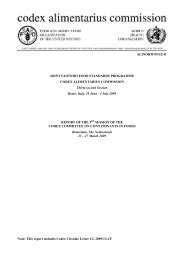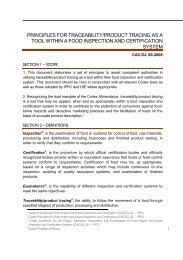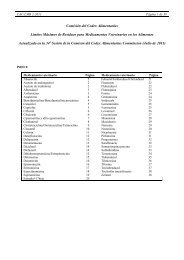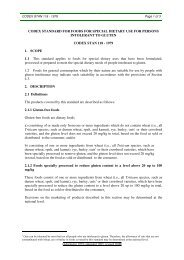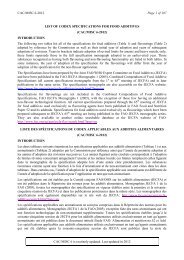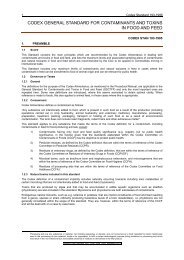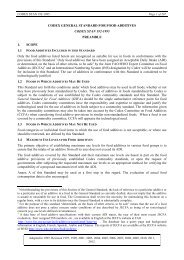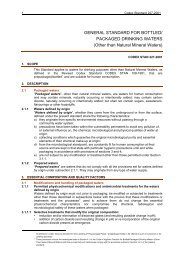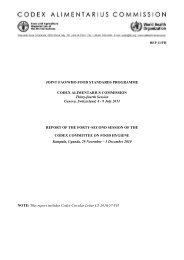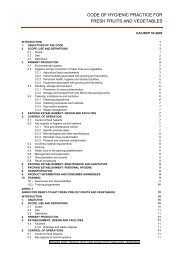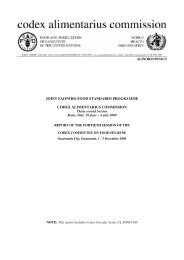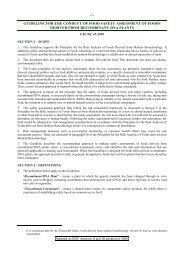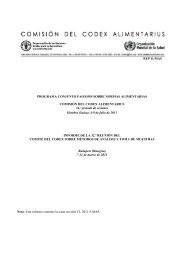proposed draft guidelines for the validation of food safety control
proposed draft guidelines for the validation of food safety control
proposed draft guidelines for the validation of food safety control
You also want an ePaper? Increase the reach of your titles
YUMPU automatically turns print PDFs into web optimized ePapers that Google loves.
CAC/GL 69 - 2008 Page 3 <strong>of</strong> 16<br />
Interrelationships among Validation, Monitoring and Verification<br />
There is <strong>of</strong>ten confusion among <strong>the</strong> concepts <strong>of</strong> <strong>validation</strong>, monitoring and verification. Validation <strong>of</strong><br />
<strong>control</strong> measures as described in this document is different from monitoring and verification, which both<br />
take place after <strong>the</strong> validated <strong>control</strong> measures have been implemented. Monitoring and verification are <strong>the</strong><br />
tools used to check whe<strong>the</strong>r <strong>the</strong> <strong>control</strong> measures are being adhered to and to demonstrate that <strong>the</strong>y are<br />
operating as intended.<br />
- Monitoring <strong>of</strong> <strong>control</strong> measures is <strong>the</strong> on-going collection <strong>of</strong> in<strong>for</strong>mation at <strong>the</strong> step <strong>the</strong> <strong>control</strong><br />
measure is applied. The in<strong>for</strong>mation establishes that <strong>the</strong> measure is functioning as intended, i.e.,<br />
within established limits. Monitoring activities are typically focused on “real-time” measurements<br />
and on <strong>the</strong> per<strong>for</strong>mance <strong>of</strong> a specific <strong>control</strong> measure.<br />
- Verification is an ongoing activity used to determine that <strong>the</strong> <strong>control</strong> measures have been<br />
implemented as intended. Verification occurs during or after operation <strong>of</strong> a <strong>control</strong> measure through<br />
a variety <strong>of</strong> activities, including observation <strong>of</strong> monitoring activities and review <strong>of</strong> records to<br />
confirm that implementation <strong>of</strong> <strong>control</strong> measures is according to design.<br />
The following example <strong>for</strong> uncooked fermented sausages illustrates <strong>the</strong> interrelationship <strong>of</strong> <strong>validation</strong>,<br />
verification and monitoring:<br />
- Validation: The competent authority established <strong>the</strong> need <strong>for</strong> <strong>control</strong> measure(s) that achieve a<br />
specified log reduction in pathogenic Escherichia coli. The <strong>validation</strong> process indicated that<br />
industry could consistently achieve a specified log reduction through ensuring a specific decrease in<br />
pH during fermentation and a specific decrease in water activity during maturation, coupled with<br />
ensuring that <strong>the</strong> raw materials have less than a specified level <strong>of</strong> pathogenic E. coli based on<br />
statistically-based microbiological testing.<br />
- Monitoring: Measuring pH drop during fermentation and weight loss (or water activity) during<br />
maturation.<br />
- Verification: Periodic process <strong>control</strong> testing <strong>for</strong> pathogenic E. coli to verify that incoming levels<br />
in <strong>the</strong> raw materials are within specification and that fermentation and maturation achieve <strong>the</strong><br />
intended outcome in <strong>the</strong> semi-finished or finished product. Examination <strong>of</strong> monitoring records to<br />
check <strong>for</strong> continuous <strong>control</strong> over time.<br />
V. TASKS PRIOR TO VALIDATION OF CONTROL MEASURES<br />
Prior to <strong>the</strong> <strong>validation</strong> <strong>of</strong> <strong>control</strong> measures by <strong>the</strong> <strong>food</strong> establishment, it is important to complete certain tasks<br />
so that <strong>validation</strong> can be accomplished effectively and efficiently. The following tasks could be carried out<br />
ei<strong>the</strong>r independently or in conjunction with <strong>the</strong> establishment <strong>of</strong> GHPs, HACCP, etc.<br />
Tasks prior to <strong>validation</strong> include:<br />
a) Identify <strong>the</strong> hazards that are intended to be <strong>control</strong>led in <strong>the</strong> commodity and/or environment concerned,<br />
taking into account all relevant in<strong>for</strong>mation, including in<strong>for</strong>mation from a risk assessment if available.<br />
b) Identify <strong>the</strong> <strong>food</strong> <strong>safety</strong> outcome required.<br />
The <strong>food</strong> <strong>safety</strong> outcome can be determined in a number <strong>of</strong> ways. Industry should determine if <strong>the</strong>re<br />
are existing <strong>food</strong> <strong>safety</strong> outcomes or targets, established by <strong>the</strong> competent authority, relevant to <strong>the</strong><br />
intended use <strong>of</strong> <strong>the</strong> <strong>food</strong>. In <strong>the</strong> absence <strong>of</strong> <strong>food</strong> <strong>safety</strong> outcomes or targets established by <strong>the</strong> competent<br />
authority, targets should be identified by industry, as appropriate. Industry may also set stricter targets<br />
than those set by <strong>the</strong> competent authority.



